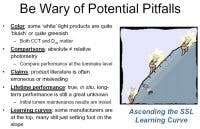From its inception in 2006 and first results in 2007, Stewart pointed out a 75% increase in average efficacy of products tested, with the highest being slightly over 70 lm/W. There was an almost 100% increase in results observed at the lower end of product performance.
Products tested in Round 7 included outdoor streetlights and bollards, downlights, replacement lamps, such as the MR16 and PAR series and omni-directional A-lamp replacements. Also, the testing included a side-by-side comparison with incumbent technologies.
For outdoor SSL luminaires, Stewart commented on the improved light quality of SSL, noting a “miserable” CRI of 21 for high-pressure sodium (HPS). Stewart noted that in a side-by-side comparison, SSL downlight performance is now exceeding that of CFL luminaires. However, the initial cost of SSL fixtures is still roughly double that of CFL fixtures.
On average, SSL MR16s are still not performing as well as the incumbent halogen technology, although there are exceptions and, on the whole, prospects are getting better for SSL. Stewart also noted that there is still a lot of ground to cover for the SSL omni-directional replacement lamps to meet either the efficacy or output of incandescent lamps or even CFLs.
Stewart reminded everyone about the potential pitfalls, including color, and that performance must be compared at the luminaire level using absolute rather than relative photometry. Also, said Stewart, product literature claims are often erroneous or misleading, and true lifetime performance, in situ, is still a great unknown.
In showing PNNL colleague Mia Paget’s favourite slide graphic, “Ascending the Learning Curve” (see diagram), Stewart reminded everyone that some manufacturers are at the top but many are still just setting foot on the slope. She cautioned everyone to “watch out for that hole in the hill”.
Full results and individual product testing and photometric reports are available on the DOE SSL website in the CALiPER program area, by agreeing to the DOE’s “no commercial use” policy. You can also find useful benchmark reports for replacement lamps and exploratory reports regarding dimming and long-term testing.
CALiPER continues to be the best source of independent testing and verification (or otherwise) of claims. It offers potential buyers and specifiers the ability to discern the difference between "good" and "evil" in today's rapidly advancing SSL industry.
SSL Product Life Issues
Eric Richman, also with PNNL, followed the Round 7 reporting with SSL Product Life Issues, opening with the questions to ponder such as “SSL life: What is it?” and “How is it measured?” Commenting that LED life is important, but “elusive”, Richman further explained that light source “life” is critical for lighting design, energy and cost analysis and characterizing the technology.
However, LEDs operate differently than other light sources and do not have a clear “end of life.” Richman explained that most light sources burn out (clearly indicating end of life!) and that lamp life is typically rated at a 50% failure rate i.e. failure of 50% of the batch of lamps under test. However, LEDs do not have a filament that can burn out, and are inherently sturdy.
As for "life" for LEDs, this is referred to as lumen maintenance or useful light output. Where all light sources degrade but most just "burn out" before serious loss of light output, LEDs continue to degrade, eventually beyond "useful light output".
Richman discussed life metrics for LEDs such as the "L" series (L70, L50) initiated by the Lighting Research Centre (LRC), which translate as a relative percentage of initial output, with L70 is relative for applications where the illuminance level is important and L50 can be applied for non-critical needs.
Richman also explained the "B" series initiated by Lumileds to relate statistical "failure" of a sample that includes low output (i.e. below L70) and component failure. In combing both metrics, the example of L70 B50 would represent the time or "life" when the light output of 50% of the LEDs in a sample will degrade to 70% of the initial light output.
Well known to seasoned industry professionals, Richman detailed the factors that affect LED "life", such as environment conditions including heat, cold and humidity, material stability including components, encapsulate and phosphors, mechanical and electrical conditions including vibration, voltage and current and last but not least, installation architecture referring to heat sinking and thermal management. The LED product will only be as good as its weakest link or in this case, component!
When discussing the measurement of LED life (i.e. lumen maintenance), Richman explained that the IES LM-80 provides measurement format and repeatability conditions and covers LED packages, arrays and modules only, not complete luminaires. He also reminded everyone that the LM-80 does not define or provide methods for extrapolating an estimation of life from the testing data.
Lifetime estimation requires lengthy testing, 6000 hours or approximately 8 months as specified by the LM-80, but this may not be enough for the best estimate as some data is showing changes near 6000 hours, commented Richman. Data at multiple temperatures is needed for use in luminaire evaluations. During the seasoning or "burn-in", a characteristic early "bump" in degradation can affect extrapolation.
The IES TM-21 or Life Estimation Test Method is intended to provide a prediction of LED lumen maintenance or lifetime. It is based upon the LM-80 testing of 6000 hours, but as mentioned earlier, some data is showing changes near 6000 hours, thus the cause to lean toward a more conservative approach. The industry is currently exploring multiple models representing potential degradation paths.
Richman's "bottom line" summary stated that LED “life” is primarily tied to anticipated level of light output and that more testing is needed to comfortably understand LED lumen maintenance. He cautioned everyone to be mindful of the lack of LED operational failure as "End of Life" and to consider a conservative approach when assigning a value to lifetime.






